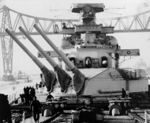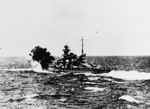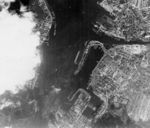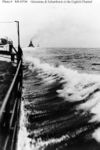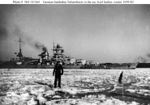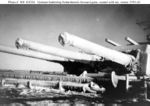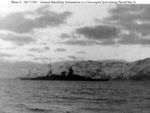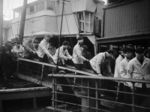User:Cruiser_Haguro:na/Sandbox/history
Contents
Construction
- Wilhelmshaven Navy Yard
- Laid down: 16 May, 1935
- Launched: 30 June, 1936
- Commissioned: 07 January, 1939
Specifications
- 36,108 tons displacement, standard
- 230m length
- 30m beam
- 9.1m draft (mean)
Machinery
- 12 boilers, 3 turbines
Performance
- 32knts at 160,080shp
- 9,020nm range at 15kn
Armor
- Main belt: 320mm mid, 70mm forward, 90mm aft
- Upper belt: 35mm
- Torpedo bulkhead: 45mm
- Decks: 105mm main, 50mm upper armored deck
- Bulkheads: 150mm forward, 200mm aft
- Barbettes and Turrets: 350mm barbette, 360mm face, 110-200mm side, 170mm rear, 90-150mm roof
- Conning tower: 350mm
Armament
Nine (3x3) 280mm rifles, twelve (4x2, 4x1) 150mm rifles, ten (5x2) 105mm dual purpose guns. Twelve (6x2) 37mm and ten (10x1) 20mm AA guns.
Aircraft
Two Ar196 float planes, two catapults
History
Design
The Scharnhorst class began as an extension of the previous Panzershiffe design which resulted in the Deutschland class cruisers. Because Germany was still nominally bound by the restrictions imposed under the Treaty of Versailles, the initial plan was to build a successor class to the Deutschland which would replace Elsass and Hessen, two pre-dreadnoughts Germany had been allowed to keep under the Versailles terms.
It was in the early 1930s, as France began construction of the Dunkerque class, that design priorities began to change. Where the original concept was a 15,000-18,000 ton ship armed with nine 280mm guns in three turrets, the decision to change the new design so as to be competitive with the Dunkerque began to expand the size of what was to become the Scharnhorst class. The new design eventually called for sufficient armor to protect against the expected 330mm guns of Dunkerque as well as a repetition of the two triple 280mm armament of the previous Deutschland class. Weighing in at 26,000 tons, the navy was unhappy with the design, but two were ordered and laid down anyway in 1934. Just six months later, in July 1934, Adolf Hitler changed his mind, and the final design advocated by the navy, with the characteristic three triple 280mm armament and a final displacement of 35,540 tons, was authorized. The two ships were re-laid a year later.
Despite having been laid last, Gneisenau was completed first, her construction having been prioritized for propaganda purposes. She launched in May of 1938 and prepared for sea trials. Gneisenau, due to the low freeboard of the class, proved to be very “wet” and received modifications to her bow in an attempt to address the issue. Scharnhorst also received a clipper bow, hers in the summer of 1939, as well as a funnel cap. Her mainmast was repositioned at this time, stepped between her catapult and aft director. Despite changes, both ships continued to have a tendency to take water over the bow.
Service
Scharnhorst officially completed trials in July of 1939 and all modifications were completed near the end of August 1939. She began World War II by returning to Kiel where she received repairs for blast damage sustained during training. On the 21st of November, 1939, both Scharnhorst and Gneisenau were ordered to sea in the Arctic. During this patrol, they encountered and sank the armed merchant cruiser HMS Rawalpindi, returning to Germany for maintenance in January, 1940.
Having completed a second, failed sortie into the North Sea, the pair returned to port in time to participate in the invasion of Norway. Sailing in April, they, along with ten destroyers, were to cover the invasion of Narvik. Encountering HMS Renown on the 9th of April, Gneisenau came off the worse in an inconclusive engagement, with Scharnhorst sustaining significant environmental damage from the heavy seas.
Returning to port and making good all damage, both Scharnhorst and Gneisenau again sailed in support of German operations in Norway in June. On June 8, 1940, they encountered HMS Glorious and her escorts, destroyers Ardent and Acasta. They sank Glorious, but Scharnhorst was torpedoed by Acasta and was forced to make for Trondheim. Scharnhorst eventually returned to Germany in June, but it would be the end of the year before she was back in action.
In late December, 1940, both Scharnhorst and Gneisenau sailed as part of Operation Berlin in the Atlantic. Forced back to port by bad weather and mechanical failures, both ships returned within days, but sortied again on the 22nd of January, 1941. This time they managed to break into the Atlantic, and proceeded to sink twenty-two ships, returning to Brest in occupied France in March, 1941. Here they became favorite targets of the RAF, with both ships being severely damaged and spending much of the year under repair and refit. It was here where both ships received the torpedo banks which had been landed by cruisers Leipzig and Nurnburg.
Having been joined in the meantime by cruiser Prinz Eugen, on 11th February, 1942, both Scharnhorst and Gneisenau left Brest for what famously became known as the Channel Dash. While the force managed to evade British attacks, both Gneisenau and Scharnhorst struck mines, Scharnhorst twice. All ships reached Kiel on the 13th of February. Scharnhorst spent several months under repair.
It was not until January of 1943 when Scharnhorst was finally returned to action, and she was sent to the Arctic. With the increasing presence of Allied air and sea power, Scharnhorst failed to make port in Narvik until March, her earlier attempts having been abortive. Moving to Altafjord, she remained at anchor, with the exception of a single sortie with Tirpitz, until December of 1943.
Her final voyage began on the 25th of December, 1943. Ordered to intercept two Russia-bound convoys, she sortied with five destroyers. Having intercepted one of the convoys on December 26th, Scharnhorst, which had separated from her destroyer screen, was in turn intercepted by the convoy screen, which contained HMS Duke of York. Engaged, Scharnhorst was damaged by gunfire, then torpedoed, finally sinking.


